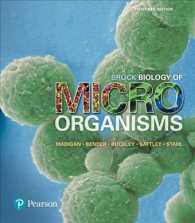Full Description
Pre-service and in-service teachers get sound instructional strategies for teaching the language arts to young children from birth to kindergarten and enhancing their reading, writing, speaking and listening development in this unique book that places children at the center of all good language and literacy teaching. This book is about teaching the language arts-about facilitating young children's reading, writing, speaking, and listening development. In a very readable manner, the book places children at the center of all good language and literacy teaching, while focusing on four central themes that run throughout the book: 1. The authors provide rich descriptions of two perspectives in children's language and early literacy learning: emergent literacy and scientifically based reading research, and equip early childhood teachers with the know how to use the instructional strategies supported by the research in both perspectives. 2.
The authors acknowledge and take into account the increasing diversity of our society and schools by providing numerous illustrations of how teachers can work effectively with diverse learners, providing special features at the end of chapters that explain how to adapt instruction for English Language Learners and children with special needs, and by providing information on the tools teachers can use to discover what each child knows and can do, in order to build on that child's prior knowledge. 3. The authors stress that assessment cannot be separated from good teaching and they describe strategies that teachers can use to understand children's language and literacy knowledge in the context of specific learning and teaching events, while also focusing on today's increasingly important "accountability" function of assessment and standardized testing instruments. 4. The authors acknowledge the importance of the family in young children's language and literacy development and include descriptions of how early childhood teachers can connect with families and engage caregivers in their children's school or center.
Contents
Contents
Preface
chapter1 Foundations of Language and Literacy
Before Reading This Chapter, Think About . . .
Focus Questions
Language and Literacy: Definitions and Interrelationships
A Continuum of Instructional Approaches
Emergent Literacy Approach
Scientifically Based Reading Research Approach
Blended Instruction-A "Value-Added" Approach
A Blended Literacy Instructional Program
Effective Early Childhood Teachers Provide Children with a Print-Rich Classroom Environment
Effective Teachers Demonstrate and Model Literacy Events
Effective Teachers Explicitly Teach Children Skills that Research Supports as Key Elements of Reading, Writing, and Speaking
Effective Early Childhood Teachers Provide Opportunities for Children to Work and Play Together in Literacy-Enriched Environments
Effective Early Childhood Teachers Link Literacy and Play
Effective Early Childhood Teachers Encourage Children to Experiment with Emergent Forms of Reading and Writing
Effective Early Childhood Teachers Provide Opportunities for Children to Use Language and Literacy for Real Purposes and Audiences
Effective Early Childhood Teachers Make Use of Everyday Activities to Demonstrate the Many Purposes of Reading and Writing
Effective Early Childhood Teachers Read to Children Daily and Encourage Them to Read Familiar Books on Their Own
Effective Early Childhood Teachers Know the Nation's and their State's Birth to Kindergarten Standards and Provide Instruction Linked to These Standards
Effective Early Childhood Teachers Use Multiple Forms of Assessment to Find Out What Children Know and Can Do
Effective Early Childhood Teachers Respect and Make Accommodations for Children's Developmental, Cultural, and Linguistic Diversity
Effective Early Childhood Teachers Recognize the Importance of Reflecting on Their Instructional Decisions
Effective Early Childhood Teachers Build Partnerships with Families
Summary
n Linking Knowledge to Practice
chapter4 Organizing Early Language and Literacy Instruction
n Before Reading This Chapter, Think About . . .
n Focus Questions
Why Classroom Environments Are Important
Designing a Print-rich Classroom Environment
The Classroom Library Center
BOOKS
PHYSICAL CHARACTERISTICS
The Writing Center
GATHER THE NEEDED MATERIALS
ARRANGE THE MATERIALS
COMPUTERS AND WORD PROCESSING
WRITING IN OTHER CENTERS
Literacy-Enriched Play Centers
Environmental Print and Functional Print
ENVIRONMENTAL pRINT
fUNCTIONAL pRINT
Organizing the Classroom's Daily Schedule: Using Time Wisely
What Happens During Whole-Group Time?
What Happens During Small-Group Activity Time?
What Happens During Center or Activity Time?
Transitions
Strategies for Teaching English Language Learners: Modifying the Classroom Environment by Myae Han
Strategies for Teaching Children with Special Needs: Adjusting the Daily Schedule
Summary
n Linking Knowledge to Practice
chapter5 Facilitating Early Language Learning
n Before Reading This Chapter, Think About . . .
n Focus Questions
Explicit Vocabulary Instruction
Encouraging Personal Narratives
Teacher D








